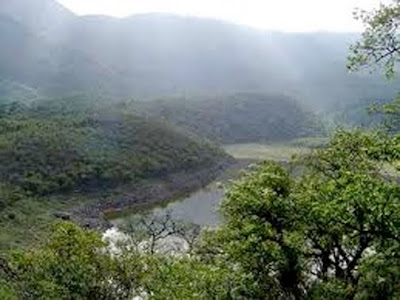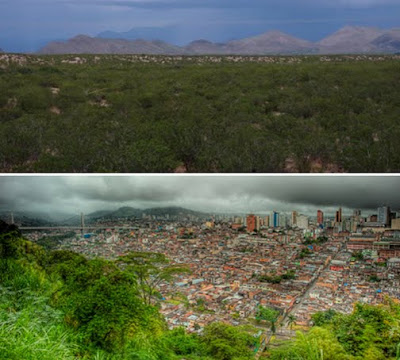In looking at the Andean region of South America, which is recognized as one of six global areas that saw the indigenous development of civilization (Peru, Ancient Egypt, Mesopotamia, Indus Valley, Yellow River and Mesoamerica), Peru has effectively a dual economy with a relatively modern sector on the coastal plains and a predominantly subsistence sector in the sierra. Subsistence is a type of farming where people grow what they eat, build their own houses, and live without regularly making purchases in the marketplace. This subsistence is a grain-growing agriculture, predominantly wheat and barley, first begun in the Nile, Euphrates and Indus River valleys, around the fifth millennium B.C. and continued on until market-based enterprise became widespread.
 A quebradas between the ranges, fertile, beautiful, and part of the capital parts of the land
A quebradas between the ranges, fertile, beautiful, and part of the capital parts of the landIn the north of Peru, near the Ecuador border, a temperate, fertile valley is surrounded by barren hills in the northern Peruvian Andes. Its tranquil, green valley was once dotted with quishar, que–al, aliso, capuli, and nogal trees and flora. This valley lies between the Cordillera Negra to the west, and the Cordillera Blanca to the east. In between lie narrow valleys called “quebradas,” and between both cordilleras runs the Santa river through a green and well populated valley called Callejon de Huaylas. Today, the largest cities in the region lie between these ranges, including Recuay, Huaraz, Carhuaz, Yungay and Caraz.
 Top: An ancient quebradas before planting; bottom: a current quebradas that is now a major city
Top: An ancient quebradas before planting; bottom: a current quebradas that is now a major cityToward the north of these quebradas that make up the capital parts of the land between the ranges, lies the ancient city of Cajamarca, which is the most important city in Peru's northern highlands. It was the place of origin for the pre-Inca culture of Cajamarca, and goes back to B.C. times. Pre-Chavin cultures can be seen in surrounding archaeological sites such as Cumbe Mayo and Kuntur Wasi, and the city traces its cultural heritage back to between 1000 and 200 B.C.
Cajamarca has an equatorial climate, and the richness showed by its pastures and the fecundity (producing abundantly; fertility) of its soils is extraordinary. This area was once covered with native forests and rich topsoil, forming part of an important watershed. Its relatively low highlands areas, with respect to the rest of the national territory, have been favored with a huge mineral richness. Not only gold, silver and copper but also molybdenum and tungsten are extracted in this zone. Ancient gold and silver jewelry workings and outstanding pottery all tell us of the Cajamarca culture in B.C. times. Julio C. Tello, famed Andean archaeologist, reports that the Maranon or Cajamarca culture appeared before 200 B.C. In a nearby settlement named Huacaloma, remains date to 1000 B.C.
The treasure-filled city of Cajamarca Peru is considered the Cultural and Historical Heritage of the Americas. The city has always been noted as a major center of religion, military power and administration. When the Inca took over around 1400 A.D., Cajamarca became an important Incan cultural center and their weavers showed excellence in their workmanship, which reflected the dominant culture of the times. However the Inca never did reach the perfection of the pre-Inca in ceramics, weaving, and the use of gold and silver. Today, Cajamarca still works its farms, mines and handcraft traditions. The weather of Cajamarca is temperate - they have an average annual temperature of 57 degrees Fahrenheit, and their rainy season extends from December until March.
Today Peru is the eighth largest gold producer in the world and largest in South America. The nearby region of Yanacocha has been converted into an industrial gold mine. The combined potential output of the Pierina mines in the north and Yanacocha make up 60% of Peruvian gold production. Yanacocha is one of the largest heap leachable gold mines in the world with production costs of $88 per ounce (year 2000 estimate) and reserves in excess of 35 million ounces of gold. In its first week of operation, Yanacocha yielded over a ton of gold
(See the next post, “City of Bountiful in the Land of Bountiful, Part III,” for the third installment of locating the city of Bountiful)




No comments:
Post a Comment